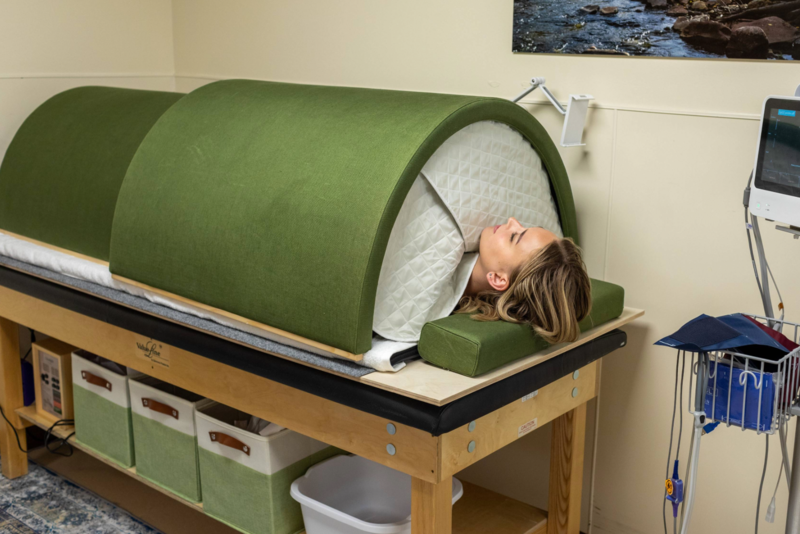News
Can Heat Help Heal Depression? Vail Health is Researching the Possibilities

Vail Health is continually looking for innovative, science-backed ways to elevate physical and mental health. One of the newest areas its research team is studying is the effects of heat on depression, and specifically the purposeful use of elevated temperatures to trigger positive health outcomes. The Vail Health Behavioral Health Innovation Center (BHIC) research team is focused on safe, scalable interventions that could complement traditional therapies and offer new hope to those who haven’t found relief from their depression through conventional care alone. The team believes this may be more than just a trend. From professional athletes to longevity researchers, heat exposure is gaining traction as a powerful catalyst for mental clarity, emotional balance, metabolic health, and physical resilience.
The Mind-Body Connection: You Can't Treat One Without the Other
Vail Health’s research transcends the outdated view that mental and physical health are separate. Instead, the research proves that the two are not separated, and we should not treat them as separate. Mood, cognition, stress, inflammation, immunity and energy are all linked. That’s why the work at BHIC is centered on whole-person care. Teams are researching how acute (limited-time) adaptive environmental stressors—like heat (sauna)—can be safely used to enhance the body’s natural capacity for building physical and emotional resilience and healing.Why Heat? The Biological Benefits
Heat is proven to boost brain chemistry, and specifically a protein called brain-derived neurotrophic factor (BDNF), which supports neuroplasticity, helps neurons grow, and is often depleted in individuals with depression. Heat also enhances serotonin and endorphin release. These are your natural mood elevators, and heat may help stimulate their production. Heat therapy has been shown to reduce inflammatory markers, promoting cellular repair. This is important because we know that chronic low-grade inflammation is associated with depression. Repeated heat exposure may improve heart rate variability (HRV) and autonomic nervous system regulation, both of which are often dysregulated in depression and anxiety. Finally, heat exposure, particularly in the evening (e.g., sauna or hot bath), can lower cortisol, support melatonin production and improve sleep depth and duration.How to Practice Heat Training Safely
Heat training doesn’t require extreme temperatures or professional athletic status. It’s accessible to almost anyone. Methods of heat training include heated exercise sessions, sauna therapy, hot water immersion and heated yoga or mobility workouts.- Heated exercise could include anything from indoor cycling and power yoga to walking on a treadmill or strength training in a warmed environment (80–100°F). Start with a 15-20 minute workout and build up gradually, being sure to stay well-hydrated.
- With access to an infrared or traditional sauna (150–180°F), the ideal duration is 15-30 minutes two to four times per week.
- Soak in a hot bath or hot tub at approximately 104°F for 15–20 minutes post-exercise or in the evening for relaxation.
- Yoga or mobility work in a heated room (80–100°F) for about an hour can offer physical and psychological benefits.
Safety Guidelines
While heat training can be highly beneficial, it’s not for everyone. Consult a medical provider first if you:- Have a history of heart disease, uncontrolled hypertension, or kidney disease.
- Are pregnant.
- Have neurological disorders that impair heat regulation (e.g., MS).
- Take medications that impair sweating or hydration, such as certain antidepressants or diuretics.
In addition, take the following precautions to ensure you are training safely:
- Hydrate aggressively before, during, and after sessions.
- Include electrolytes, especially if sweating heavily.
- Acclimate gradually: Full heat adaptation takes 7–14 days.
- Never train to exhaustion in heat — build tolerance over time.
- Cool down afterward with hydration, stretching, or a cool shower.
- Train with someone; it is always best to have a buddy.
A New Frontier in Healing
Heat training, when performed safely and intentionally, shows real promise for helping treat depression. It also improves performance, recovery, resilience, cognition and overall emotional well-being.To learn more about Vail Health Behavioral Health Innovation Center’s studies, or if you’re interested in participating in a study, visit VailHealthBH.org/Research.
More News
-
New!
More

Screening Secrets: What Every Man Should Know About Prostate Cancer Screening
Prostate cancer is the most common type of non-skin related cancer in men, and it is the second leading cause of cancer-related deaths in men within the United States, behind lung cancer. Fortunately, if caught early, prostate cancer remains highly treatable and curable with minimally invasive procedures.
-
New!
More

Unplug to Recharge: Why a Digital Detox Is the Real Power Move for 2026
Our phones promise connection, convenience and control, yet most of us feel more scattered, stressed and sleepless than ever. The constant pings, scrolls and notifications have rewired our brains for distraction. The fix? Not abandoning technology altogether, but reclaiming balance.
-
New!
More

Beyond the Scale: Why Nutrition and Exercise Work Better Together
For decades, weight loss advice has been distilled into a simple equation: calories in, calories out. Eat less, maybe combine that with exercise, and the pounds will fall away. But according to experts at Vail Health, that equation overlooks a much bigger picture.





